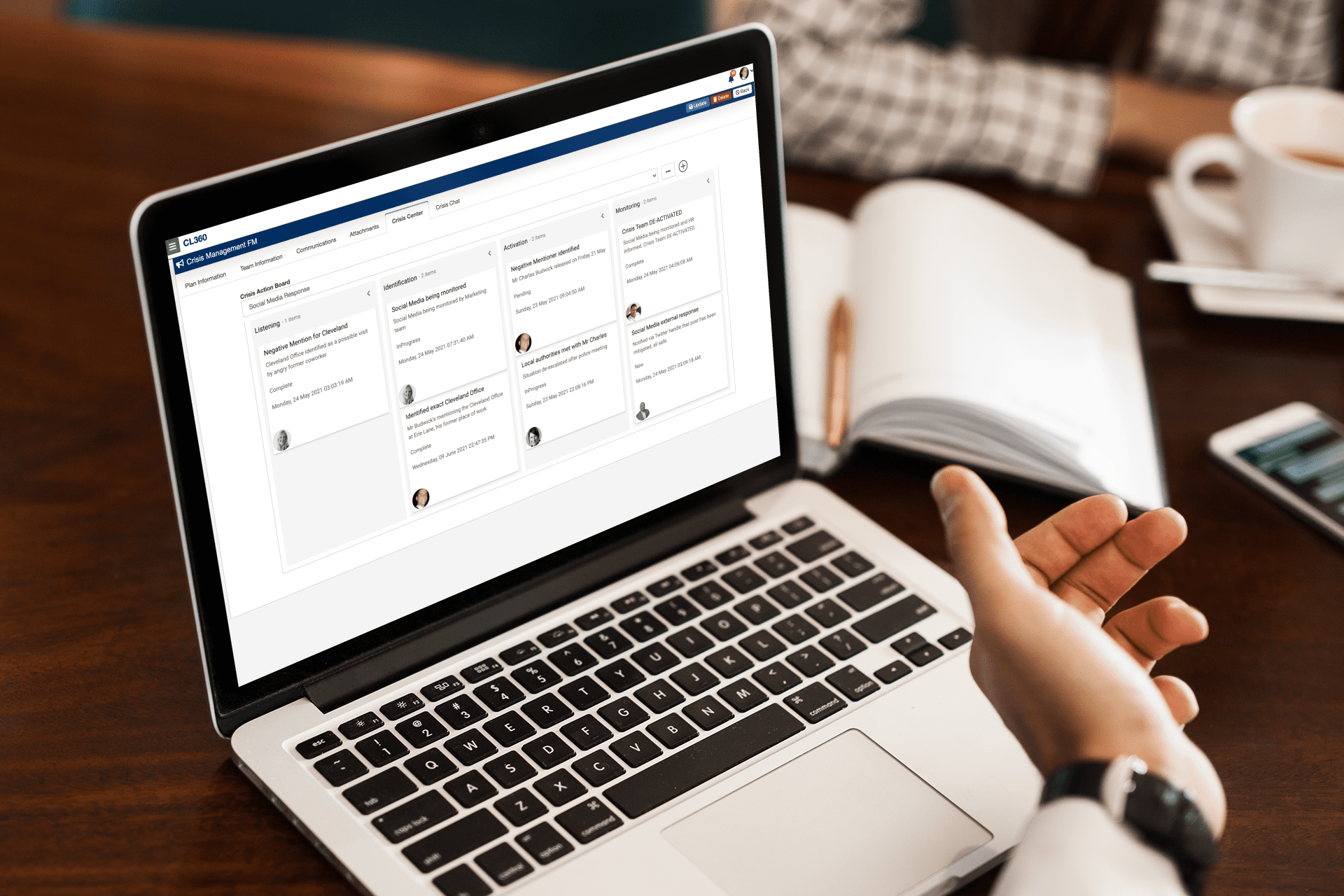Crisis Management
The CLDigital 360 Crisis Management app empowers crisis responders with real-time data at time of incident. Users can collaborate in a digital chatroom within the platform, keep track of key decisions, and generate Situation Reports as needed. Kanban boards help to manage multiple swim lanes, high-level tasks, progress, and stakeholders; and can simply be dragged and dropped from one stage (pre-crisis) to the following stage (activation). Visual cards present leaders a holistic picture of all activities along with profile cards of those owning the milestones. Pre-configured or customized Crisis Playbook templates are easily modified by severity, tiers, or type of crises with no coding required. Outputs and alerts are auto-generated based upon activities and escalations, and our Microsoft connector allows for a visually impactful output for quicker decision-making by senior leadership.

Key Components:
- Privileged role-based access
- Real-time data feeds
- Mobile-friendly situation reports
- Crisis playbooks
- Kanban boards
- Boardroom worthy plan output built in MS Word
- Simple or advanced workflows
- No-code configuration and change management
- Mobile browser and native mobile app available
The Importance of Crisis Management Software
An effective crisis response is crucial to an organization’s resilience in an era of constant change and unpredictable threats. A major incident requires a level of coordination and strategic oversight that exceeds standard incident management. Crisis management software provides the central command center and the solution your organization needs to navigate these high-stakes events. It enables clear communication among response teams and stakeholders, effectively manages critical tasks, and provides decisive leadership with situational awareness. A dedicated platform transforms static response plans into dynamic, actionable workflows, ensuring all personnel are aligned and prepared.
Trends in Crisis Management Software
The field of emergency management is constantly evolving, and the technology that supports it is advancing just as quickly. Leveraging modern tools and approaches is vital to maintain effective resilience and continued success. Key trends shaping today’s crisis management landscape include:
- Integrated platforms. Organizations are moving away from siloed tools toward unified platforms that combine crisis management, business continuity, and incident management. This holistic approach ensures seamless collaboration and a complete view of organizational risk.
- AI and automation. Artificial intelligence is being used to analyze data for enhanced situational awareness and automate routine tasks, alerts, and notifications. This frees up responders to focus on critical decision-making.
- Mobile-first response. A crisis can happen anywhere at any time. Mobile capabilities are now essential, allowing response teams to access plans, execute tasks, and communicate from any device, ensuring a swift and coordinated incident response.
- Proactive training and simulation. Modern software facilitates realistic training exercises and simulations. This helps prepare all personnel for their roles in a crisis, builds muscle memory, and improves the effectiveness of your response plans.
Why Choose CLDigital?

We empower your organization to master crisis management with a flexible and powerful platform. Our crisis management software provides a single source of truth, enabling real-time collaboration and clear crisis communication when it matters most. With CLDigital, you can operationalize your response plans through dynamic playbooks and automated workflows, ensuring a consistent and effective response to any incident. We provide the tools to manage tasks, engage stakeholders, and give your leadership team the situational awareness required to protect your people, assets, and reputation, helping you build a more resilient future.
Built to provide intelligence and situational awareness during a crisis
The CLDigital 360 Crisis Management app creates a dynamic view of the enterprise with the lens of a crisis manager. With no coding, different tiers of crisis response can be nested at various levels of the enterprise and allow for roll-up communications and tracking. Local, regional, corporate, and other critical response teams have roles-based access, allowing them to provide relevant data and collaborate in support of event resolutions.
The CLDigital 360 Crisis Management app brings real-time data and teams together with a common operating picture. Meetings, actions, tasks, stakeholders, and milestones are all captured within the system which can generate alerts, notifications, activate playbooks, and publish situational reports easily. This provides an organized way to keep stakeholders up to date with action boards, chat rooms, and boardroom-quality output presentable on any device.

